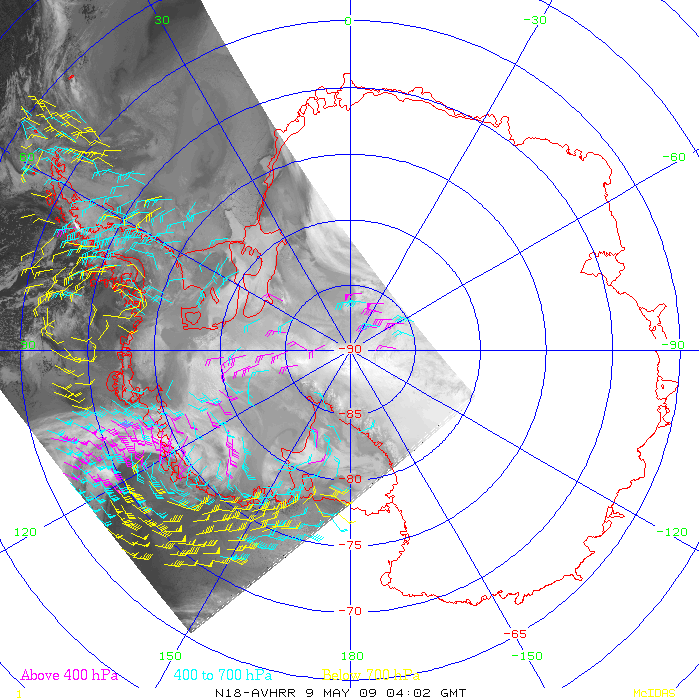
[ Archive ]

 |
ASPB and CIMSS Weekly Report
[ Archive ] |
 |
IN THE PRESS:
ITEMS FOR THE ADMINISTRATOR:
ITEMS FOR THE ASSISTANT ADMINISTRATOR:
ITEMS FOR THE OFFICE DIRECTOR, STAR:
AVHRR HRPT Winds from Rothera, Antarctica: As
part of the continuing effort to make polar wind information available
to numerical weather prediction (NWP) centers as quickly as possible,
winds are now being generated from Advanced Very High Resolution
Radiometer (AVHRR) data collected at the United Kingdom's High
Resolution Picture Transmission (HRPT) receiving station in Rothera,
Antarctica. The first winds were generated on May 1, 2009. Rothera is
on the Antarctic Peninusula and therefore provides excellent coverage
of western Antarctica, complementing the direct broadcast Moderate
Resolution Imaging Spectroradiometer (MODIS) winds generated at
McMurdo. All processing is done on-site at Rothera. In contrast to the
AVHRR Global Area Coverage (GAC) winds generated at the Cooperative
Institute for Meteorological Satellite Studies (CIMSS) and in NESDIS
operations, the HRPT wind information is available much sooner and at a higher
spatial resolution. The Rothera HRPT winds will be made available to
NWP centers after testing and validation. (J. Key, E/RA2, 608-263-2605,
jkey@ssec.wisc.edu; D. Santek, CIMSS, 608-263-7410; C. Velden, CIMSS, 608-262-9168)
 (Click image to enlarge)
(Click image to enlarge)
Figure caption: AVHRR winds generated with direct readout data at Rothera, Antarctica, on May 9, 2009. Data are from NOAA-18.
ITEMS FOR THE DIVISION CHIEF, CoRP:
Paper on Hurricane Forecasts with Full Spatial Resolution AIRS Soundings Published: A manuscript entitled "Improved Hurricane Track and Intensity Forecast Using Single Field-of-View Advanced IR Sounding Measurements" was published in the Geophysical Research Letters (2009GL038285). This paper demonstrates that the hurricane track and intensity forecast is substantially improved when Atmospheric InfraRed Sounder (AIRS) full resolution soundings are assimilated. The AIRS full resolution soundings are derived using CHISR (Cooperative Institute for Meteorological Satellite Studies, CIMSS, hyperspectral IR sounding retrieval) algorithm. Co-authors are Jun Li (CIMSS) and Hui Liu (NCAR). (Jun Li, CIMSS, Jun.Li@ssec.wisc.edu, 608-262-3755)
Data Summary Meeting for West-Pacific Typhoon Field Campaign: Howard Berger and Chris Velden from the Cooperative Institute for Meteorological Satellite Studies (CIMSS) participated in the summer Thorpex Pacific Asian Regional Campaign (TPARC) Data Management Workshop in Monterey, California. TPARC was a field campaign during the fall of 2008 investigating the genesis and intensification of typhoons in the West-Pacific. The purpose of the data meeting was to provide fellow TPARC collaborators with overviews of their collected data and exchange ideas about managing that data. Berger presented a summary of the available atmospheric motion vector and other satellite data that CIMSS had generated throughout the campaign. (H. Berger CIMSS, C. Velden 608-262-9168)VISITORS:
NEXT WEEK:
LOOKING AHEAD:
| Archived Weeklies Page | Submit a report item |